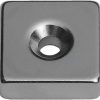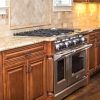Magnetic Latches: Keeping Your Kitchen and Office Organized
We’ve all had that one cabinet door that wouldn’t stay shut. Maybe the hinges were on an angle or maybe the cabinet itself was unlevel. Regardless of the reason, the door was a constant hazard for bumping your head or knee as you moved around the kitchen.
Modern cabinet fixtures have a solution to this problem: Magnets. So even if you make the rash decision to install the cabinet on the ceiling, there’s no chance of the door opening on its own.

Magnets in the Kitchen
The general concept is rather simple: A magnet is attached inside the cabinet door, and another is placed right inside the cabinet, flush against the edge. When the two magnets come close, they attract each other, snapping the cabinet closed with a satisfying Click! In the simplest designs, these latches will use countersink magnets. This allows users to drill through the magnet so the top of the screw sits flush with the face of the magnet. In some cases, these can be installed inside the wood so they don’t protrude at all. However they’re installed, the magnets attract each other to ensure the door remains shut.
An example of a countersink magnet.
Other designs are a bit more intricate, with a larger catch. This allows users to install the catch on top of the bottom cabinet shelf, instead of along the cabinet face. The catch is often a thin, box-like item with a magnet protruding from the face. A user will then install a magnetic plate on the inside of the door so that when it closes, the plate and catch meet. The idea is the same as the countersunk magnet design: Two magnets attract to keep the door closed.
